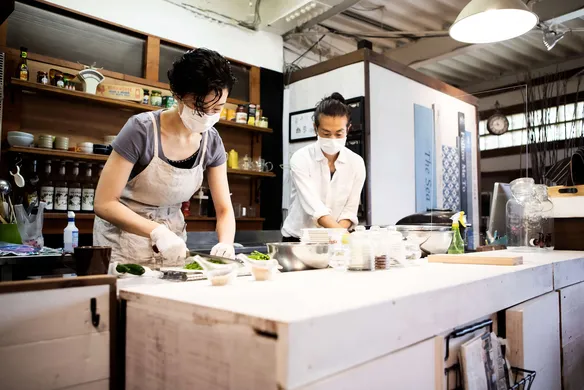Table of contents
With the COVID-19 pandemic upending the food-service industry throughout 2020 and 2021, new models for operating restaurants have been gaining ground.
Ghost kitchens – sometimes called dark kitchens or cloud kitchens – are one approach that can help restaurants run at a reduced cost. Their impact is expected to stick around well past the pandemic: Ghost kitchens are gaining widespread popularity across Australia despite not yet being well understood by Australian diners.
Could operating a ghost kitchen help your restaurant survive and thrive in the years to come? Here’s a look at what ghost kitchens are and how they may (or may not) fit within your restaurant business.
What is a ghost kitchen?
A ghost kitchen is essentially a stand-alone or off-premises kitchen facility that prepares meals for takeaway or delivery. It may operate to serve a single restaurant’s needs, or exist as a shared production kitchen for multiple restaurants – in this model, ghost kitchens have an independent team that is managed by the location instead of one specific restaurant.
Restaurants use ghost kitchens in a variety of ways, as the model is flexible for restaurateurs’ needs and goals. Expansion is one such goal: A restaurant may partner with a shared production kitchen outside its current delivery range, for example, and have that kitchen prepare food for delivery-only orders in that new geography while the main restaurant still operates in a traditional manner.
Alternatively, some restaurateurs are responding to the pandemic by pivoting to ghost-kitchen-only concepts. By choosing to launch their own ghost kitchens and run delivery- or takeaway-only restaurants – often in partnership with third-party marketplaces like Uber Eats or Menulog – restaurateurs can eliminate many overhead costs while still driving sales and growing their brands through virtual channels.
Is a ghost kitchen right for you?
For restaurants looking to open up a second kitchen to support their growing business or increasing delivery volume, partnering with a ghost kitchen may be a good way to do so while keeping costs down. Especially at a time when operating a traditional brick-and-mortar restaurant involves not only the typical costs of full-time wages, rent and utilities but also the added challenges of enhanced cleaning requirements and reduced capacity rates (to accommodate social-distancing and local guidelines), opening a traditional second location may not be financially feasible.
However, ghost kitchens come with unique considerations. In some versions of the shared-production partnership model, for example, the primary restaurant has no say in how the ghost-kitchen food turns out and none of its own personnel are involved in making it – risking its reputation if the kitchen delivers a poor-quality product.
Launching a ghost-kitchen-only concept is even riskier, as it requires building a customer base for takeaway and delivery only (and using extensive marketing savvy to successfully win new and repeat orders through third-party apps). Using social media to grow name recognition and establish a following before, during and after launch can help solidify the concept but may not be enough to drive orders.
And even with the very best planning and marketing, there’s no certainty a ghost-kitchen-only concept will be successful. Traditional restaurants fail all the time despite their ability to drive face-to-face relationships with customers. Sustaining a virtual-only restaurant requires sustaining virtual-only relationships, which may prove too challenging for delivery-only concepts to stay afloat.
There are many questions and considerations for restaurateurs to keep in mind if they’re considering incorporating ghost kitchens into their operations.
Consider the restaurant’s objectives: Are you looking to close your brick-and-mortar space to do only delivery and takeaway instead of onsite dining, add delivery that you don’t offer now, or expand delivery and takeaway to new locations? How soon do you want the ghost kitchen to be operational? The answers will help restaurateurs determine their goals and ask the right questions of potential operator-partners.
Take into account your existing infrastructure: How effectively are your current point-of-sale and kitchen display systems serving the business – especially when it comes to takeout and delivery? A restaurant’s technology and payment solutions must be integrated with an effective online-ordering infrastructure to support a ghost-kitchen concept.
Factor in potential costs and ongoing volume: Will your ongoing order volume offset your contractual costs to a ghost kitchen operator? What is your potential for profit? Since shared-kitchen operators charge startup costs and monthly fees to restaurateurs, smaller restaurants should run cost calculations to determine if any ghost-kitchen partnership makes economic sense for expenses and delivery/order volume.
The future of ghost kitchens
The use of ghost kitchens across the restaurant industry is expected to grow in the years to come.
According to research firm Euromonitor, ghost kitchens could be a $1 trillion global market by 2030. That’s because faster, cheaper delivery may capture large percentages of revenue that traditionally funnels into other areas of the food-service market, such as drive-through service, takeaway, ready meals and on-premises dining.
Between now and 2030, every individual restaurateur must decide if their business’s unique challenges or growth plans can be effectively addressed by opening a delivery-only location or pivoting to a ghost-kitchen concept. Conditions may be making it all the more important for restaurants to adapt, but incorporating a ghost kitchen may not be the right fit for every business.
This article is for educational purposes and does not constitute legal, professional or medical advice. For specific advice applicable to your business, please contact a professional.
![]()











